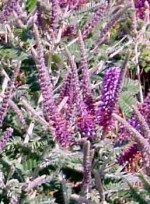 A native of woods, savannas, and prairies from Ontario and Manitoba, south to Louisiana, Texas, and New Mexico, leadplant is a small shrub with silvery green leaves and bluish-purple flowers with bright orange anthers. White hairs cover the stems and leaves so that it appears to be covered with lead dust, giving it the common name leadplant. Its other common name, prairie shoestring, derives from the laced-shoestring look of the leaves and roots. Plants are deep rooted and so are very resistant to drought and recover quickly after a fire . Leadplant tolerates a wide variety of soils including ones that are nutrient poor and, in fact, adds nitrogen to the soil. Although it will tolerate some shade, it prefers full sun, and tends to sprawl in less light. Deer and rabbits love it.
A native of woods, savannas, and prairies from Ontario and Manitoba, south to Louisiana, Texas, and New Mexico, leadplant is a small shrub with silvery green leaves and bluish-purple flowers with bright orange anthers. White hairs cover the stems and leaves so that it appears to be covered with lead dust, giving it the common name leadplant. Its other common name, prairie shoestring, derives from the laced-shoestring look of the leaves and roots. Plants are deep rooted and so are very resistant to drought and recover quickly after a fire . Leadplant tolerates a wide variety of soils including ones that are nutrient poor and, in fact, adds nitrogen to the soil. Although it will tolerate some shade, it prefers full sun, and tends to sprawl in less light. Deer and rabbits love it.
Type: Shrub
Attributes: Flowers and foliage; food for wildlife
Form: Flat topped mound
Growth Rate: Slow to moderate; takes about three years to bloom
Bloom: Small bluish-purple flowers with orange anthers are born in slender spikes 2-6” long in mid-summer and are followed by glossy brown, crescent shaped seed pods.
Foliage: Silvery-green compound leaves are bipinaate, 4-12” long.
Size: 3’ H x 3-6’ W
Light: Full sun; tolerates some shade but sprawls and produces less flowers
Soil: Average to rich, moist to dry, well-drained, neutral to moderately alkaline; tolerates nutruient poor, rocky or sandy soil.
Fertilizer: Not needed
Hardiness: Zones 2-8
Care: Prune to shape and remove dead steams in spring.
Pests and Diseases: None of significance
Propagation: Scarified seeds in fall; stratified seed in spring.
